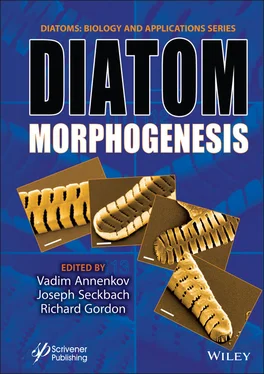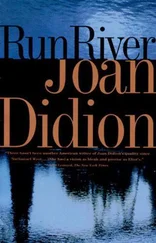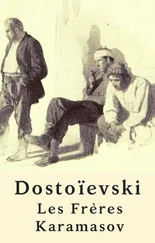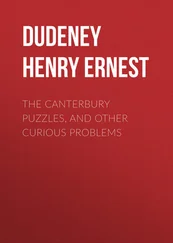Diatom Morphogenesis
Здесь есть возможность читать онлайн «Diatom Morphogenesis» — ознакомительный отрывок электронной книги совершенно бесплатно, а после прочтения отрывка купить полную версию. В некоторых случаях можно слушать аудио, скачать через торрент в формате fb2 и присутствует краткое содержание. Жанр: unrecognised, на английском языке. Описание произведения, (предисловие) а так же отзывы посетителей доступны на портале библиотеки ЛибКат.
- Название:Diatom Morphogenesis
- Автор:
- Жанр:
- Год:неизвестен
- ISBN:нет данных
- Рейтинг книги:5 / 5. Голосов: 1
-
Избранное:Добавить в избранное
- Отзывы:
-
Ваша оценка:
- 100
- 1
- 2
- 3
- 4
- 5
Diatom Morphogenesis: краткое содержание, описание и аннотация
Предлагаем к чтению аннотацию, описание, краткое содержание или предисловие (зависит от того, что написал сам автор книги «Diatom Morphogenesis»). Если вы не нашли необходимую информацию о книге — напишите в комментариях, мы постараемся отыскать её.
A unique book presenting the range of silica structures formed by diatoms, theories and hypotheses of how they are made, and applications to nanotechnology by use or imitation of diatom morphogenesis.
Audience
Diatom Morphogenesis — читать онлайн ознакомительный отрывок
Ниже представлен текст книги, разбитый по страницам. Система сохранения места последней прочитанной страницы, позволяет с удобством читать онлайн бесплатно книгу «Diatom Morphogenesis», без необходимости каждый раз заново искать на чём Вы остановились. Поставьте закладку, и сможете в любой момент перейти на страницу, на которой закончили чтение.
Интервал:
Закладка:
2.4.4 Future Research—Symmetry, Stability and Directionality in Diatom Morphogenesis
We measured and characterized instability, but what are the characterizations of stability—i.e., is stability periodic, monotonic, or something else? Characterization of stability may be informative concerning the end products of epigenetic, morphogenetic, or other processes, or at times during the morphogenetic process when apparent stasis occurs as no discernable change in morphology, symmetry, or other structural state. Characterization of the behavior of stability during morphogenesis may enable inferences about directionality and irreversibility at an evolutionary level. Research along this line has implications for studies of diatom valve formation and morphological evolution.
Improvements to assessing such systems for the factors enabling directionality with respect to stability or instability are in the offing by using Lyapunov co-vectors [2.39]. These co-vectors are associated with stable and unstable manifolds via Lyapunov exponents along trajectories in a dynamical system [2.39, 2.101], and they are also associated with entropies with respect to Lyapunov exponents [2.39, 2.110]. There are positive Lyapunov exponents associated with forward Lyapunov co-vectors, and negative Lyapunov exponents associated with backward Lyapunov co-vectors [2.77]. These Lyapunov co-vectors do not directly indicate time; however, they can indicate directionality, and inferences about directionality with respect to time may be determined. Directionality with respect to valve formation changes at species-level or higher taxonomic category may be informative about diatom evolution.
To determine directionality, irreversibility and degree of indistinguishability among symmetry states need to be assessed within a dynamical morphogenetic system. Changes in instability behavior, at which points, stability occurs, are potentially a multidimensional and multiscale problem. Chaotic instability may be a part of directionality for shorter time spans in contrast to long term random instability potentially for all dimensions and scales during the morphogenetic process. More detailed work is necessary to determine the contributions of stability and instability as well as symmetry at each morphogenetic stage. A more exacting representation is needed of diatom valve formation in morphogenesis concerning irreversibility of the process and indistinguishability of symmetry states and their associated valve formation stages.
If successive states of instability via symmetry states are found during diatom valve formation or morphogenesis more broadly, how does this impact diatom morphological complexity [2.107] over time? Additionally, what happens to morphological complexity over long time periods at stationarity? The expectation is that dynamical complexity is related to chaotic instability [2.22] and that increasing complexity occurs over time. Algorithmic information theory may be used to tie symmetry to complexity and to determine the role of instability over time, and in turn, gain an understanding of another facet of diatom morphogenesis.
References
[2.1] Albrecht-Buehler, G., Daughter 3T3 cells. Are they mirror images of each other? J. Cell Biol. ,72, 3, 595–603, 1977.
[2.2] Alicea, B. and Gordon, R., Toy models for macroevolutionary patterns and trends. BioSystems , 122, Special Issue: Patterns of Evolution, 25–37, 2014.
[2.3] Alicea, B. and Gordon, R., Cell differentiation processes as spatial networks: Identifying four-dimensional structure in embryogenesis. BioSystems , 173, 235–246, 2018.
[2.4] Alvare, G. and Gordon, R., CT Brush and CancerZap!: Two video games for computed tomography dose minimization. Theor. Biol. Med. Modell ., 12, 1, 7, 2015.
[2.5] Amr, I.I., Amin, M., El-Kafrawy, P., Sauber, A.M., Using Statistical Moment Invariants and Entropy in Image Retrieval. Int. J. Comput. Sci. Inf. Secur ., 7, 1, 160–164, 2010.
[2.6] Aragon, J., Barrio, R., Woolley, T., Baker, R., Maini, P., Nonlinear effects on Turing patterns: Time oscillations and chaos. Phys. Rev. E , 86, 2, 026201, 2012.
[2.7] Astauroff, B.L., Analyse der erblichen Storungsfalle der bilateralen Symmetrie [Analysis of hereditary disorders of bilateral symmetry] [German]. Z. Indukt. Abstamm. Vererbungsl ., 55, I, 183–262, 1930.
[2.8] Atay, F.M., Jalan, S., Jost, J., Randomness, Chaos, and Structure. Complexity , 15, 1, 29–35, 2009.
[2.9] Attneave, F., Some informational aspects of visual perception. Psychol. Rev ., 61, 3, 183–193, 1954.
[2.10] Benci, V. and Menconi, G., Some remarks on the definition of Boltzmann, Shannon and Kolmogorov entropy. Milan J. Math ., 73, 1, 187–209, 2005.
[2.11] Bentley, K., Clack, C., Cox, E.J., Diatom colony formation: A computational study predicts a single mechanism can produce both linkage and separation valves due to an environmental switch. J. Phycol ., 48, 3, 716–728, 2012.
[2.12] Bentley, K., Cox, E.J., Bentley, P.J., Nature’s batik: A computer evolution model of diatom valve morphogenesis. J. Nanosci. Nanotechnol ., 5, 1, 25–34, 2005.
[2.13] Biederman, I., Recognition-by-components: A theory of human image understanding. Psychol. Rev ., 94, 2, 115–147, 1987.
[2.14] Biederman, I., Mezzanotte, R.J., Rabinowitz, J.C., Scene perception: Detecting and judging objects undergoing relational violations. Cogn. Psychol ., 14, 2, 143–177, 1982.
[2.15] Bissantz, N., Holzmann, H., Pawlak, M., Testing for image symmetries-with application to confocal microscopy. IEEE Trans. Inf. Theory , 55, 4, 1841–1855, 2009.
[2.16] Boltzmann, L., Uber die Mechanische Bedeutung des Zweiten Hauptsatzes der Warmetheorie [On the Mechanical Meaning of the Second Law of Heat Theory] [German]. Wien. Ber ., 53, 195–220, 1866.
[2.17] Boltzmann, L., Vorlesungen uber Gastheorie, vol. I [Lectures on Gas Theory] [German] , vol. 1, J. A. Barth, Leipzig, Germany, 1896.
[2.18] Boltzmann, L., Vorlesungen uber Gastheorie, [Lectures on Gas Theory] [German] , vol. II, J. A. Barth, Leipzig, Germany, 1898.
[2.19] Bredov, D. and Volodyaev, I., Increasing complexity: Mechanical guidance and feedback loops as a basis for self-organization in morphogenesis. BioSystems , 173, 133–156, 2018.
[2.20] Burge, J., McCann, B.C., Geisler, W.S., Estimating 3D tilt from local image cues in natural scenes. J. Vision , 16, 13, 2, 1–25, 2016.
[2.21] Chaitin, G.J., Algorithmic information theory. Ibm J. Res. Dev ., 21, 4, 350–359, 1977.
[2.22] Chakrabarti, C.G. and Ghosh, K., Biological evolution: Entropy, complexity and stability. J. Mod. Phys ., 2, 6, 621–626, 2011.
[2.23] Chen, C.T., Linear System Theory and Design , 4 thed, Oxford University Press, New York, NY, USA, 2013.
[2.24] Chen, Q., Shi, J.C., Tao, Y., Zernicka-Goetz, M., Tracing the origin of heterogeneity and symmetry breaking in the early mammalian embryo. Nat. Commun ., 9, 1819, 2018.
[2.25] Cox, E.J., Willis, L., Bentley, K., Integrated simulation with experimentation is a powerful tool for understanding diatom valve morphogenesis. BioSystems , 109, 3, Special Issue on Biological Morphogenesis, 450–459, 2012.
[2.26] Crutchfield, J.P. and Feldman, D.P., Regularities unseen, randomness observed: Levels of entropy convergence. Chaos , 13, 1, 25–54, 2003.
[2.27] Dammig, M. and Mitschke, F., Estimation of Lyapunov exponents from time series: The stochastic case. Phys. Lett . A, 178, 5–6, 385–394, 1993.
[2.28] De Martino, A., Amato, A., Bowler, C., Mitosis in diatoms: Rediscovering an old model for cell division. Bioessays , 31, 8, 874–884, 2009.
Читать дальшеИнтервал:
Закладка:
Похожие книги на «Diatom Morphogenesis»
Представляем Вашему вниманию похожие книги на «Diatom Morphogenesis» списком для выбора. Мы отобрали схожую по названию и смыслу литературу в надежде предоставить читателям больше вариантов отыскать новые, интересные, ещё непрочитанные произведения.
Обсуждение, отзывы о книге «Diatom Morphogenesis» и просто собственные мнения читателей. Оставьте ваши комментарии, напишите, что Вы думаете о произведении, его смысле или главных героях. Укажите что конкретно понравилось, а что нет, и почему Вы так считаете.












